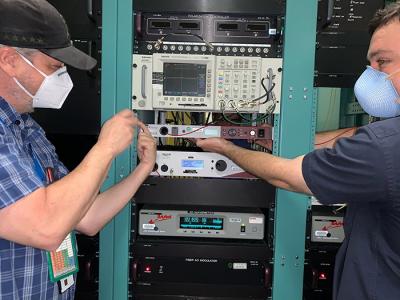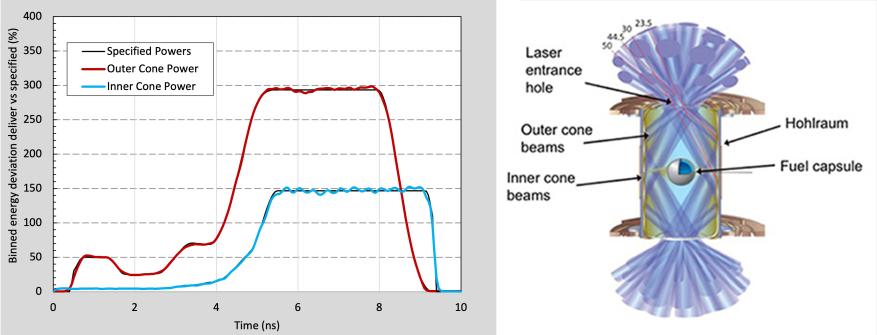Fourth in a series of articles describing the elements of the National Ignition Facility's fusion breakthrough.
To achieve fusion ignition on Dec. 5, 2022, the National Ignition Facility (NIF)'s laser system needed to operate flawlessly at both ends of the performance spectrum, delivering immense energies while controlling the energy balance across all 192 laser beams with extreme precision.
To reach that historic milestone, Lawrence Livermore National Laboratory (LLNL) scientists took advantage of a modest increase in NIF's laser energy output to 2.05 megajoules (million joules, or MJ) of ultraviolet energy. This was 8% more than the 1.9 MJ that was available for the Aug. 8, 2021, experiment that brought NIF to the threshold of ignition.
The designers also were able to further fine-tune how this energy interacted with the peppercorn-sized target capsule through meticulous adjustments in the laser beams' wavelengths (see "Designing for ignition: Precise changes yield historic results").
"NIF is a big hammer, it's extremely energetic," said Jean-Michel Di Nicola, NIF's chief systems engineer for laser systems. "But brute force alone is not enough. We need to have finesse and make sure that we deliver that energy with exquisite accuracy."
This impressive combination of power and finesse, built and refined over several decades of effort by generations of NIF & Photon Science laser scientists and engineers, gave NIF the capability to achieve its long-sought goal of conducting a thermonuclear fusion experiment that reached ignition and exceeded scientific "break-even" - producing more fusion energy than the amount of laser energy used to drive the target (see "Star power: Blazing the path to fusion ignition").
"It's quite a grand challenge to do that because the laser architecture is extremely complex and a marvel of laser physics, engineering and optics manufacturing," Di Nicola said.
Boosting laser performance
From their inception as a single weak pulse of light in the Master Oscillator Room (MOR), NIF's high-energy laser beams travel nearly 5,000 feet in just five microseconds, bounding along a route that crisscrosses the length of three football fields before emerging as a powerful blast of energy when they impact the target.
Along their journey, the beams pass through about 7,500 large half-meter-sized optics and 26,000 smaller ones that amplify their energy and direct them to a pencil-eraser-sized target, called a hohlraum, inside the target chamber. Opened for experiments in 2009, NIF's original design specification was to deliver 1.8 MJ of ultraviolet energy with a peak power of 500 terawatts (TW).
"Since the completion of the National Ignition Facility Project in March 2009," said Bruno Van Wonterghem, NIF facility manager, "we have continuously increased the energy and power over a few years to make sure that we were obtaining the regime where implosion experiments could take place in relevant conditions. And in July 2012, we shot the first hohlraum at 1.9 MJ and 430 TW. This started a decade of inertial confinement fusion (ICF) research that finally enabled us to demonstrate burning plasmas and approach ignition."
The 2021 experiment that reached the ignition threshold was a significant milestone, but NIF's experimental designers were stymied in their attempts to repeat the result, chiefly because subsequent target capsules were not as perfectly constructed as the one used that day.
Even the tiniest imperfections - such as microscopic pits and voids in the capsule and perturbations initiated by the fuel fill tube - caused implosion asymmetries that led to degraded implosions and limited the neutron yield.
A bigger hammer
By last summer, NIF's laser and optics teams implemented advances in optics science and engineering to turn up the laser energy to 2.05 MJ while increasing the thickness of the capsule. This boost proved to be a game-changer for the "layered" implosion performance (NIF capsules contain a thin layer of cryogenically cooled deuterium [D] and tritium [T] along with a volume of DT gas).
"Wonderfully, fantastically, we had a new option available to us, made available by increasing the laser energy delivery to the target," said Richard Town, associate program director for ICF science. "This motivated capsule design changes to use the new 2.05 MJ laser capability to drive heavier, more stable capsules."
Town said the experimenters were able to "thicken up" the fuel capsule by 6% to 8% to make it less susceptible to degradations from imperfections. "And it worked," he said. "Basically, that extra energy - that bigger hammer - hitting a slightly thicker target brought us in a more favorable regime, and we achieved ignition."
Fine-tuning finesse
Still, even with the increased energy, more fine-tuning of the laser wavelengths was needed to balance the new recipe of laser energy and capsule thickness. This was where finesse - delivering the laser beams into the hohlraum and around the fuel capsule at just the right time, power profile and at the correct wavelengths to drive a near round, highly symmetrical implosion - was crucial.
"The laser itself also has to be perfectly balanced," Town said. "If you drive [the capsule] harder from the top than the bottom, you'll introduce thin spots and you'll see jetting of the fuel, the first degradation mechanism."
In addition, driving the laser energy too hard from the top and the bottom of the hohlraum produces a flat pancake-shaped implosion, while pushing too hard from the sides produces a prolate, or sausage-shaped, implosion. "Both of those degrade the performance," Town said.
The capability to adjust laser wavelengths was built into NIF when it originally opened and was refined over time. A key three-year project that was completed last summer modernized the MOR - known as the "heart of the laser" - from the oscillator to the pulse-shaping system input (see "NIF's Master Oscillator Room upgrade completes key milestone").
Imagine, Di Nicola said, holding a standard low-power laser pointer used in classrooms and in presentations, but with a special button that allowed you to alternate between brighter and less bright light. Then imagine standing on the other end of the beam watching waves of laser light coming at you.
Similarly, he said, "If you were at the middle of the target chamber, you would see a wave coming at you," taking about 8 billionths of a second. "Initially, you would be on the low burner at 50 terawatts of power and then you would feel a little bit of a dip, going lower, then going up and finally having a big push and [experiencing] 300 terawatts for the outer cone of beams."
Even with the new laser energy boost and thicker capsule, a Sept. 19, 2022, NIF shot produced 1.2 MJ of energy, falling just short of the August 2021 milestone. The imaging data from NIF's diagnostics suggested that some of the laser's energy was wasted because the implosion was observed to be oblate, or significantly out-of-round.
Putting the 'I' in NIF
For the December shot, the team made a tiny change, measured in angstroms, in the relative wavelength of the inner and outer cone of beams hitting the middle of the hohlraum wall. To put this in context, one angstrom is 10-10 of a meter and one-ten thousandth of the fundamental wavelength of the NIF laser.
"We changed the wavelength separation - a one-fourth angstrom difference between the outer and inner cones - so that we diverted some of the energy to the equator, and that led to a round implosion," said experimental physicist Joe Ralph. "So we went from an oblate implosion to a round implosion, and that essentially got to our 1.5x gain. At this point, we put the 'I' in NIF.
"Not only is NIF an amazing high-energy, high-power laser, but it's also a very precise pulse-shaping laser," Ralph said.
NIF Director Gordon Brunton praised literally thousands of scientists, engineers and staff from LLNL and other national laboratories, universities and industry who contributed over the last six decades to the laser advances that made ignition possible.
"I'm proud being part of this team," Di Nicola said. "Being part of this human and scientific adventure is really rewarding."
Future articles in this series will detail the roles of improved optics and targets, computer modeling and simulation, diagnostic-driven understanding of NIF implosions and operations and support personnel; and describe plans for facility upgrades, the development of inertial fusion energy and future experiments.
See Part 1: Star power: Blazing the path to fusion ignition
See Part 2: Designing for ignition: Precise changes yield historic results
See Part 3: Ignition experiment advances stockpile stewardship mission
Next Up: "NIF's Optics Meet the Demands of Increased Laser Energy"
- Benny Evangelista








